
Guests
- Clara Gutteridgehuman rights investigator. Her recent piece for The Nation is called “How the US Rendered, Tortured and Discarded One Innocent Man.”
A new exposé by human rights investigator Clara Gutteridge for The Nation magazine looks at secret U.S. operations in Africa and how the United States rendered, tortured and discarded one innocent man from Tanzania. Suleiman Abdallah was captured in Mogadishu in 2003 by a Somali warlord and handed over to U.S. officials, who had him rendered to Afghanistan for five years of detention and torture. Imprisoned in three different U.S. facilities, Abdallah said he was subjected to severe beatings, prolonged solitary confinement, forced nakedness and humiliation. He said he was also sexually assaulted, locked naked in a coffin, and forced to lie on a wet mat, naked and handcuffed. Abdallah was finally released in July 2008 from Bagram Air Force Base — with a piece of paper confirming his innocence. However, he has received neither reparations nor apologies for his ordeal. “The worst of the torture, we’re not authorized to talk about, because it’s too painful for him,” Gutteridge says. “What I can say is that he was subject to some of the worst torture that I have ever encountered in interviewing over a hundred U.S. torture victims.” [includes rush transcript]
Transcript
JUAN GONZÁLEZ: We turn now to a shocking new story about U.S. secret operations in Africa. The Nation magazine has just published an exposé titled “How the US Rendered, Tortured and Discarded One Innocent Man.” The article by human rights investigator Clara Gutteridge recounts the ordeal of a Tanzanian man named Suleiman Abdallah. He was captured in Mogadishu in 2003 by a Somali warlord and handed over to U.S. officials, who had rendered him to Afghanistan for five years of detention and torture. Imprisoned in three different U.S. facilities, Abdallah said he was subjected to severe beatings, prolonged solitary confinement, forced nakedness and humiliation. He said he was also sexually assaulted, locked naked in a coffin, and forced to lie on a wet mat, naked and handcuffed. Suleiman was finally released in July 2008 from Bagram Air Force Base—with a piece of paper confirming his innocence. However, he has received neither reparations nor apologies for his ordeal.
For more, we’re joined in London by Clara Gutteridge. She used to work as a secret prisons investigator at the human rights organization Reprieve.
Welcome to Democracy Now!
CLARA GUTTERIDGE: Thank you.
JUAN GONZÁLEZ: Could you lay out for us how you came across this case and how you got involved in Suleiman Abdallah’s situation?
CLARA GUTTERIDGE: My job at Reprieve used to be finding disappeared people, people who had been disappeared by the United States in the context of the war on terror. And, you know, my methods were quite varied, but one of the things I used to frequently do would be to interview people who had just been released from one of these secret prisons and ask them about the other people that they were detained with. And they could usually remember quite well who was there. And so, from that, I kind of built up this list of people. [inaudible] 2007 onwards, my work increasingly focused on East Africa, and I had this list of people that I would always ask [inaudible]—
JUAN GONZÁLEZ: We seem to have lost Clara Gutteridge. We’re going to try to see if we can get her back. Her recent piece for The Nation is called “How the US Rendered, Tortured and Discarded One Innocent Man.” We’re trying to see if we can get that connection back. OK, well, we’ll take a break while we try to see if we can get Clara Gutteridge back on the line. This is Democracy Now!, democracynow.org. We’ll be back in a minute.
[break]
JUAN GONZÁLEZ: This is Democracy Now!, democracynow.org, The War and Peace Report. I’m Juan González. We’re still having trouble getting to Clara Gutteridge, so we’re going to move now to Peru…
JUAN GONZÁLEZ: We’re joined now by the British human rights investigator, Clara Gutteridge, we had on before, before we had the difficulties. We were talking with her about the U.S. secret operations in Africa. The Nation magazine has just published her exposé titled “How the US Rendered, Tortured and Discarded One Innocent Man.” The story recounts the ordeal of a Tanzanian man named Suleiman Abdallah.
Clara Gutteridge, welcome back to Democracy Now! Hopefully we’ll be able to keep you on the line this time. Continue with where you left off, talking about how you learned of Suleiman Abdallah’s situation.
CLARA GUTTERIDGE: OK, thanks.
So I was saying that my job at Reprieve a couple of years ago involved, essentially, building files on people who had disappeared in the context of the U.S. war on terror, people who were being held in the network of secret prisons around the world. And one of the cases I was building a file on was Suleiman Abdallah’s. And routinely, what I would do would be things like interview people that had just been released from U.S. detention, put that together with other sorts of documentation, then, hopefully, ultimately, find out where somebody was being held and get representation—get authorization to represent them in prison.
But the thing that happened with Suleiman’s file was that it just grew and grew and grew, and I still had no idea where he was. So I found out all of this really fascinating stuff about, you know, how he’d been picked up in Somalia in 2003, sold by a warlord, funny things about his personality and his life. His nickname is Travolta, because he was very fond of dancing—things like this. But I had no idea, you know, where he was being held. And I would—every time I met somebody that had been held in one of these prisons, I would ask them, “Do you know, Suleiman Abdallah, an East African man?” And the answer was always no. And then, eventually, in 2008, I learned off record that he was being held in Bagram Air Force Base in Afghanistan, which is or was essentially Guantánamo Bay’s lesser-known, more evil twin. And then, not long after that, I heard through kind of NGO contracts that he had been released and that he was at home in Tanzania or in the island of Zanzibar. And so, I went to meet him.
JUAN GONZÁLEZ: Well, can you trace for us his amazing odyssey from country to country and how this happened?
CLARA GUTTERIDGE: Right. Well, I mean, it’s been—it’s very difficult to piece together, obviously. And we only know, you know, some of—some of what happened. But he’s from Zanzibar. He grew up in Zanzibar, like many people from that island. He was fond of fishing, and he was, you know, good with boats. And so, he ended up being a kind of itinerant trader going up and down the coast from Zanzibar up the Kenyan coast to the southern bit of Somalia, which is also Swahili-speaking. And he was kind of trundling up and down in his boat and then ended up in Mogadishu, where he got a job for a couple of weeks.
And then he was abducted by a notorious warlord whose name is Mohamed Dhere, who still lives in Mogadishu—in fact, he’s one of the most powerful people in Somalia still, he’s had various roles in successive Somali governments—sold for a bounty to Americans, presumably, members of the CIA, who rendered him via Djibouti and Kenya to secret prisons in Afghanistan. And in Afghanistan, he was held, first of all, in a prison he called “The Darkness,” which we think is a prison called the “Dark Prison,” where prisoners are held in pitch black with music pumping 24 hours a day, where they’re like very, very seriously abused, no access to lawyers; then taken to a prison called the “Salt Pit,” which was slightly better, although not much better; and then, ultimately, to Bagram Air Force Base, where he was held for about five years, until he was ultimately released, sent back to Tanzania in 2008.
JUAN GONZÁLEZ: And the original reason why the U.S. government took him and jailed him?
CLARA GUTTERIDGE: Right. Well, this is obviously—is very difficult to piece together, because the U.S. government won’t talk about why this happened. But it seems as though—so, in Somalia, between 2002 and 2005, there was this system of—essentially, the CIA would pay warlords money for so-called terror suspects. The same thing happened in Pakistan. Eighty-five percent of the people in Guantánamo Bay, in fact, were sold for a bounty in Pakistan rather than being picked up off any battlefield. And in Somalia, this was going on, as well, although it was much quieter, there was less attention. And we think that Suleiman may have originally been sold as—passed off, if you like, as a notorious terror suspect called Fazul, who was ultimately, you know, killed only last year. Of course, he wasn’t Fazul. He was a nobody from Tanzania. One thing we have noticed is that it tends to be kind of what tended to be the more kind of light-skinned, foreign-looking people that were sold, you know, maybe because, you know, as in Pakistan, it was more Arab-looking people, so people that could be passed off as something—something suspicious.
JUAN GONZÁLEZ: And I summarized in the introduction some of what he went through, but could you describe for us what you learned was some of the torture and the treatment that he underwent, the abuses that he underwent?
CLARA GUTTERIDGE: Right. Well, I mean, the worst of the torture, we’re not authorized to talk about, because it’s too painful for him to talk about, and he doesn’t want it to be made public. What I can say is that he was subject to some of the worst torture that I have ever encountered in, you know, interviewing over a hundred U.S. torture victims. He was routinely beaten. He was sexually assaulted. He was locked in a cage. He was locked in a kind of—in a coffin-shaped box. He was subjected to extreme temperatures of hot and cold. He was threatened that, you know, he would never be released again. You know, the list really is endless. It took—it took, you know, two intensive days of debriefing for the medical experts to document what he went through. So, obviously, I can’t really summarize it all in such a short space of time.
JUAN GONZÁLEZ: And who did he say inflicted this torture on him?
CLARA GUTTERIDGE: You know, U.S.—generally speaking, it was a series of different people, but mainly U.S. personnel, so DOD and other—probably the CIA, although we—of course, we can’t be certain.
JUAN GONZÁLEZ: And could you tell us about the overall role of the United States forces, CIA and Special Forces in Africa, where he was originally abducted?
CLARA GUTTERIDGE: Right. So, when Suleiman was abducted in 2003, that was in the middle of this—there was this arrangement between the CIA and Somali warlords, who were then in control of most of Somalia, called—euphemistically called the Alliance of Peace and Counter-Terrorism. And what that really was was an arrangement whereby the warlords—you know, there was no—there was no law. These people were just, you know, in de facto control. The warlords would go around and would pick people up and would sell them for, you know, large amounts of money to the CIA. And at that time, people were routinely, you know, rendered off into—rendered into different parts of the world to be held in different U.S. prisons.
Now, you know, like everywhere else, the U.S.—you know, since, say, let’s say 2007, the U.S. has increasingly been seeking to get out of the detention game. It’s no longer running, you know, masses of prisons all around the world where detainees are held. But what’s happening now in East Africa is that the war on terror is very much alive and kicking, although it’s more decentralized and outsourced than it used to be, which means that the role of partner states, of local, regional states, is much more important. They’re receiving, you know, masses of money, masses of aid, to conduct counterterrorism. And what we’re increasingly seeing is that it is these states that are doing the jailing, either on behalf of the United States or perhaps in some kind of, you know, joint detention operation. And for those of us kind of working on rule of law issues and trying to ensure that these prisoners get—you know, get the rights that they deserve, it is even more difficult than working with prisons that are, you know, on the face of it, obviously run by the United States.
JUAN GONZÁLEZ: Well, I want to ask you about those U.S. operations, for instance, in Somalia. Last year, Jeremy Scahill of The Nation and Democracy Now! traveled to Mogadishu and revealed the existence of a secret CIA facility in that city.
JEREMY SCAHILL: When we arrived in Mogadishu, within days, we discovered that the CIA had just finished construction of a pretty massive compound at the Aden Adde International Airport in Mogadishu. And the compound, which is not even hidden in plain sight—it’s just in plain sight—looks like a gated community. It has about a dozen buildings inside of it, brand new. It’s a walled compound with guard posts at all of its—at each of its four corners. It’s right on the banks of the Indian Ocean. And then next to it there are six or eight small hangars. And the CIA also has its own aircraft there.
JUAN GONZÁLEZ: Yes, your response to this Jeremy Scahill report?
CLARA GUTTERIDGE: Right. I mean, you know, it is common knowledge amongst, you know, not only Somalis in Mogadishu but really most people that go through Mogadishu, you know, that this prison exists and that there is, you know, clearly, a kind of a multilateral detention operation going on in Somalia that involves, you know, secret detention of prisoners. You know, the only person [inaudible] who said to the BBC Somali Service that he didn’t know anything about it.
JUAN GONZÁLEZ: OK, and finally, Suleiman Abdallah, his situation now? He’s gotten no compensation for his years of unjust jailing or extralegal jailing?
CLARA GUTTERIDGE: Right. So, you know, Suleiman Abdallah is right now, you know, struggling against significant odds to rebuild his life after what he’s been through. U.S. torture is very, very effective at totally unraveling people, you know, but there is—there are no resources put into, you know, helping people once they’ve been released, if they’re found innocent, to put themselves back together, to rebuild their lives. And so, Suleiman is—you know, he’s doing extremely well, but, you know, it’s very, very difficult for him.
JUAN GONZÁLEZ: Well, Clara Gutteridge, I want to thank you for joining us. She’s a human rights investigator. Her recent piece for The Nation is called “How the US Rendered, Tortured and Discarded One Innocent Man.” We’ll be back in a minute.

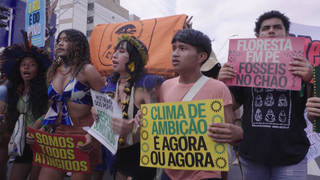
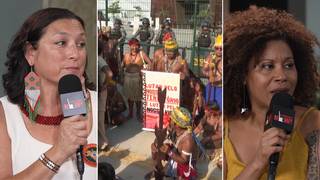
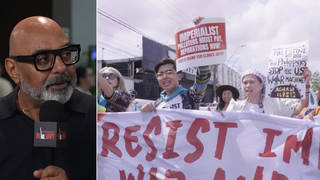
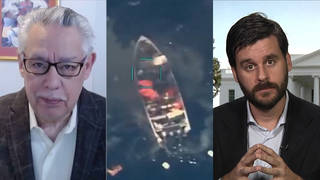






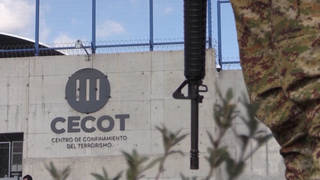
Media Options